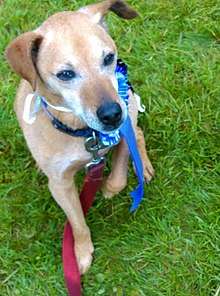Patterdale Terrier
 Patterdale Terrier | ||||||||
| Origin | England | |||||||
|---|---|---|---|---|---|---|---|---|
| ||||||||
| Notes | The Patterdale Terrier is recognized by the American Rare Breed Association | |||||||
| Domestic dog (Canis lupus familiaris) | ||||||||
The Patterdale Terrier is an English breed of dog descended from the Northern terrier breeds of the early 20th century. The origins of the breed can be traced back to the Lake District, specifically to Ullswater Hunt master Joe Bowman, an early Border Terrier breeder.
The "Patterdale Terrier" is more of a "type" rather than a "breed", being the result of a culmination of working terrier breeds indigenous to the United Kingdom.
The dogs were bred for the hunting and dispatch of the red fox in the rocky fells around the Lake District where a traditional digging dog was not always of great use. They were also used for badger control for many years. The Patterdale made its way to the United States, where it is used for groundhog, raccoon, fox and nutria with great success.
Today, the highly adaptable Patterdale Terrier excels worldwide not just at hunting a wide array of quarry, but in a number of canine sports, such as dog agility and terrier racing.
Description
Appearance
There are a number of breed standards for the Patterdale Terrier. The most notable is that of the United Kennel Club (UKC) and the American Dog Breeders Association (ADBA), both in the United States, since the United Kingdom Kennel Club does not currently recognize the Patterdale Terrier.
The UKC standard states that dogs are between 25 and 40 centimetres tall, and specifies that dogs should be in fit, working condition. The UKC standard further specifies:
An active little terrier that presents a compact, balanced image. As a working terrier, they have to be capable of squeezing through very small passages underground to follow quarry. This breed is worked far more than it is shown, and breeders are primarily concerned with the practicality of the breed. This terrier must have a strong neck, the fortitude to hold its quarry at bay, the ability to squeeze into tight burrows, and great flexibility and endurance.
Coat and Colour

The coat may be one of three types: "smooth," "broken," or "rough."
- Smooth coat: Short, glossy hair. Undercoat still usually present.
- Broken coat: Coarse. May be some longer whiskering on muzzle and chin.
- Rough coat: Longer hair overall, including face, ears, and muzzle. Very thick, protective double coat.
All coat types should have dense and coarse double coats that are harsh to the touch and weatherproof.
Colours include black, red, bronze, black and tan, chocolate, liver, or even liver and tan, along with the rare blue (which has a slate colored nose), and occasionally brindle, but never fully white. Any other colours, or larger patches of white away from the chest and toes, are indicative of cross-breeding, particularly with the Jack Russell Terrier.
Temperament
Patterdale Terrier puppies tend to be bold and confident beyond their capabilities. The Patterdale is known as a working terrier, rather than a show dog. Typical of terriers, whose work requires high energy and a strong drive to pursue prey, Patterdales are very energetic and can be difficult to socialise. Though also kept as pets, due to being bred for high-intensity work, they may tend towards being too energetic for a sedentary household life.[1]
History
These dogs were carefully linebred by Joe Bowman, an Ullswater huntsman. The modern Patterdale Terrier is to the Fell Terrier what the Jack Russell Terrier is to Hunt terriers—the indisputable leader in numbers and performance as a breed.
The Patterdale was developed in the harsh environment in the north of England, an area unsuitable for arable farming and mostly too hilly for cattle. Sheep farming is the predominant farming activity on these hills. Since the fox is perceived by farmers as being predatory with respect to sheep and small farm animals, terriers are used for predator control. Unlike the dirt dens found in the hunt country of the south, the rocky dens found in the north do not allow much digging. As a consequence, the terrier needs to be able to bolt the fox from the rock crevice or dispatch it where it is found. The use of "hard" dogs to hunt foxes in this way was made illegal in England and Wales by the Hunting Act 2004, as it runs counter to the code of practice[2] under the Act.
In the United States, the Patterdale Terrier was recognised by the United Kennel Club on January 1, 1995, but remains unrecognized by the American Kennel Club.
Dog sports
In recent years Patterdale Terriers have begun to compete in a number of modern dog sports including ones such as flyball and dog agility. Trainable terriers with working drive are prized in flyball, and Patterdale Terriers are ideal competitors in multiple disciplines of the sport.
References
- ↑ Dad jailed over baby son Reggie Young's dog bite death, BBC, retrieved 8 September 2017
- ↑ BASC Terrier Code Archived 2006-09-27 at the Wayback Machine.
External links
| Wikimedia Commons has media related to Patterdale Terrier. |
- Patterdale Terrier at Curlie (based on DMOZ)